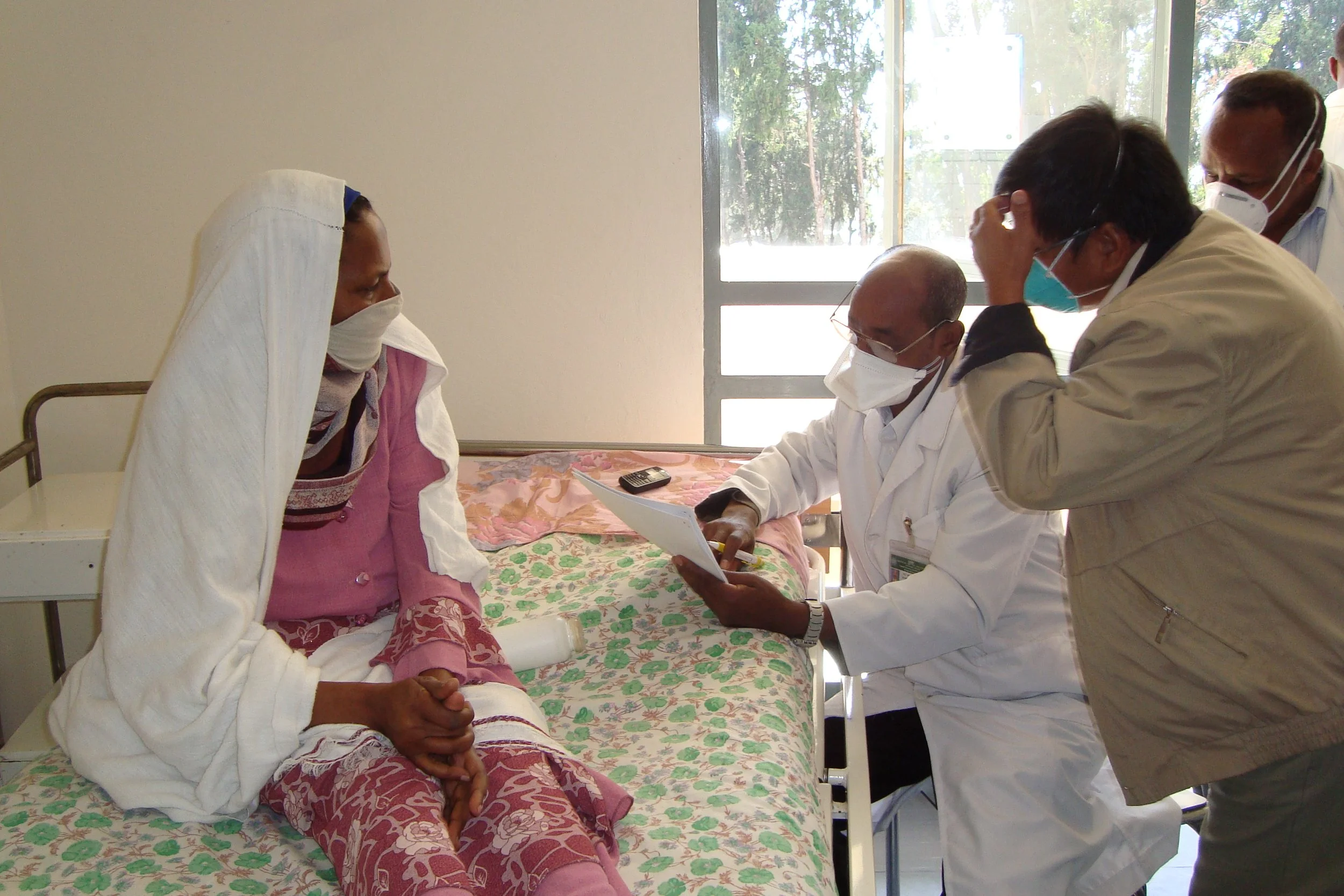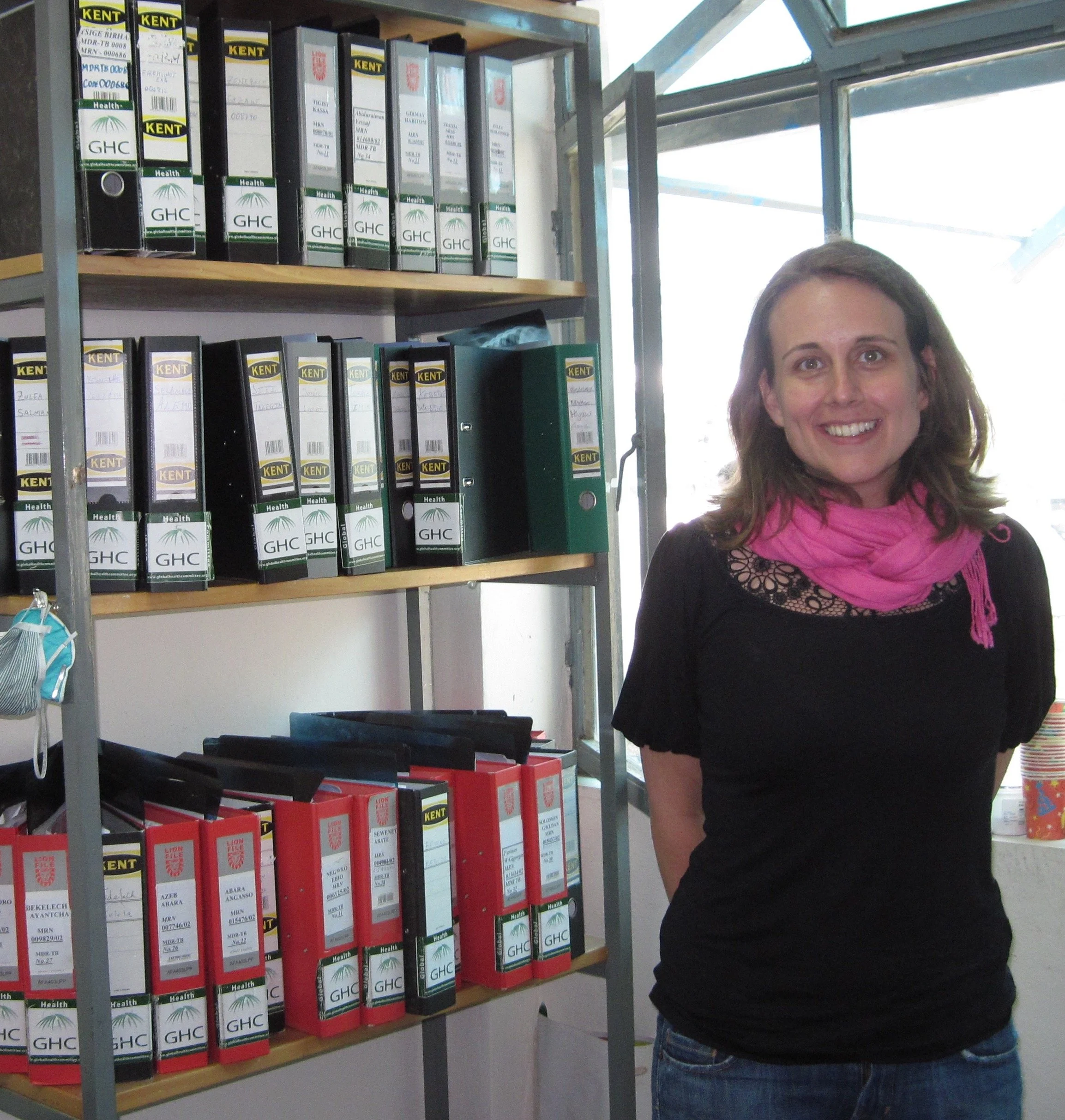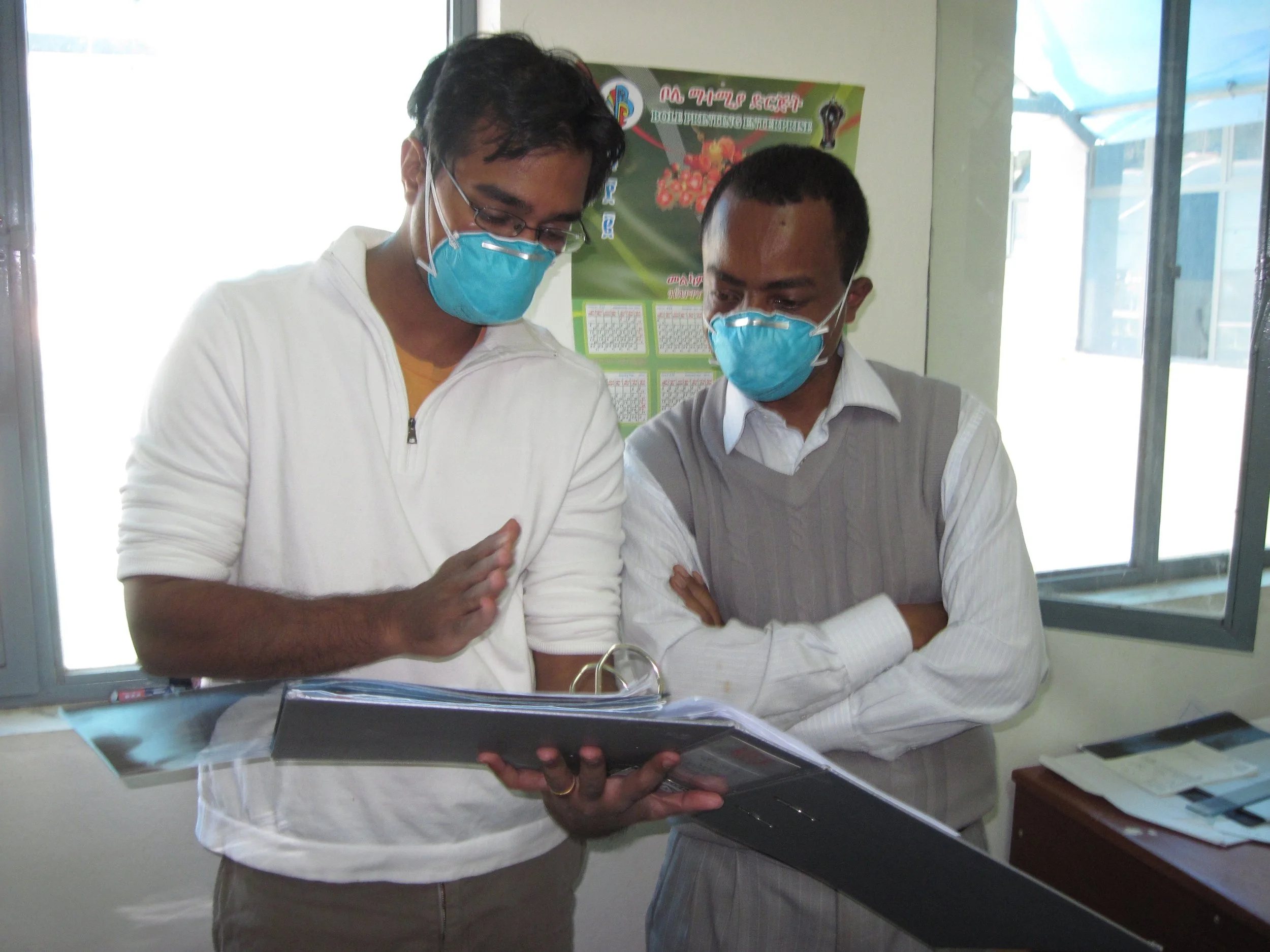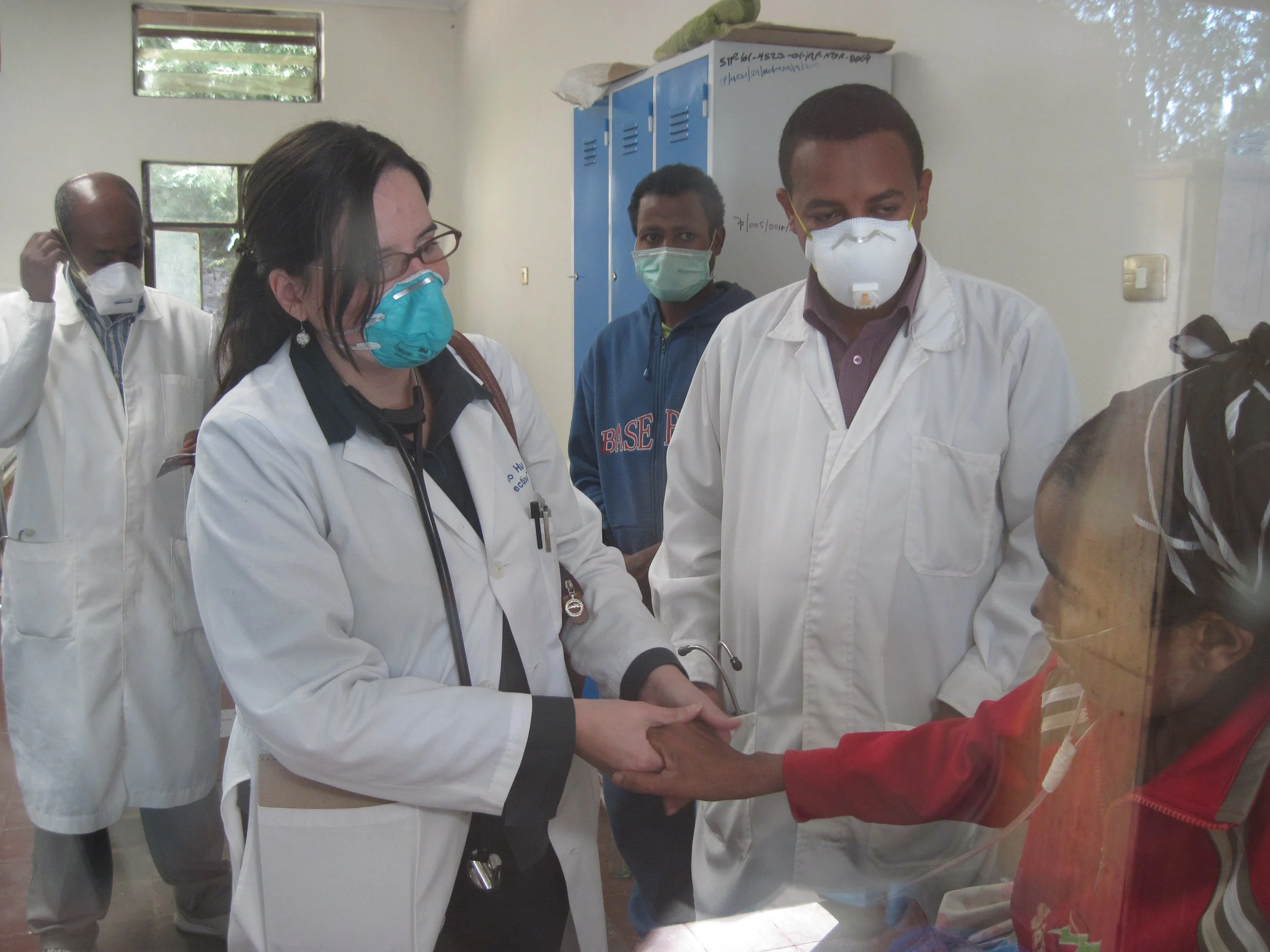
Left to Right: Kassim Abate, Physician Assistant, Dr. Daniel Meressa, and Dr. Bekele Fekadu at the DR-TB training in Cambodia Dec ‘08/Jan’09 at Angkor Wat. Kassim and Dr. Bekele have worked with GHC since 2009 and Dr. Daniel was GHC’s Medical Coordinator from 2009-2023.
Launching a South-to-South partnership from Cambodia to Ethiopia for Drug-Resistant TB
The Cambodian team supervises the Ethiopian doctors as they evaluate a patient with DR-TB in Siem Reap in 2009.
The Cambodian and Ethiopian teams celebrate the end of their training at the Angkor Wat Temple in 2009.
How GHC Overcame Barriers and Initiated MDR-TB Care in Ethiopia in 2009
When CHC first visited Ethiopia in 2008, treatment for the deadly multidrug resistant form of drug resistant TB (MDR-TB)— also referred to on our website as drug resistant-TB (DR-TB)—was unavailable in Ethiopia, the second most populous country in Africa.
Seeking to share Cambodian Health Committee’s highly successful approaches to TB and HIV with programs in Africa, CHC in partnership with Angelina Jolie and the Jolie-Pitt Foundation (JPF), decided to work with the Ethiopian Federal Ministry of Health (FMOH) to implement a program to address this humanitarian crisis.
Left untreated, it is estimated that each DR-TB patient infects at least 10 other people. At the time it was estimated that 6,000 Ethiopians were sick with DR-TB—who were spreading it unchecked, with no treatment available. Left untreated, it is estimated that each DR-TB patient infects at least 10 other people.
Although Ethiopia had secured free DR-TB drugs through WHO’s Green Light Committee, delivery was delayed by a year. Acting fast, with a donation of the capreomycin—the most expensive DR-TB drug—from Eli Lilly & Co., GHC launched treatment for Ethiopia’s first 8 patients at St. Peter’s Hospital in a repurposed ‘bird flu’ isolation ward, on February 9, 2009—just weeks after the local team returned from training in Cambodia. This required overcoming several huge obstacles working together with the FMOH as described below.
In 2009, DR-TB treatment lasted 18–24 months. The first 8 months—the 'intensive phase'—involved daily painful injections and three harsh oral drugs that often caused nausea and nerve side effects. The injectable could cause kidney or liver injury, making close monitoring and side-effect management critical to keeping patients alive and on track for a cure.
The FMOH mandated that all DR-TB patients be hospitalized during the 8-month intensive treatment phase. Indeed, in those early days of the GHC/St. Peter’s program, most patients needed extended stays due to the severity of their illness—making hospital-based care essential for survival.
Cambodian Dr. Sok Thim discussing an X-Ray showing severe DR-TB pneumonia in one lung on rounds with Dr. Bekele at St. Peter’s Hospital, Addis Ababa, Ethiopia.
Challenges to be Overcome
Challenge 1: Technical training of the Ethiopian DR-TB medical team in clinical management of DR-TB was needed to initiate care.
Response: In September 2008, CHC kicked off DR-TB training with a 1 week didactic course in Addis Ababa. Three months later, ten Ethiopian health leaders traveled to Cambodia for hands-on training in managing DR-TB under CHC’s mentorship. (See photos at the top of the page).
Challenge 2: Lack of a DR-TB treatment isolation ward. No isolation ward was available as renovations of a planned isolation ward for DR-TB at St Peters Hospital were a year behind without a clear end date.
Response: With permission from the FMOH and St Peters Hospital, GHC repurposed an unused bird flu isolation ward at St. Peter’s into Ethiopia’s first DR-TB unit. It served as the program’s base for over two years and later continued housing overflow patients needing isolation and care for several years.
Dr. Sok Thim in the foreground rounding with Dr. Bekele on the Lower DR-TB Ward of St Peters Hospital
Challenge 3: Lack of DR-TB drugs in the country and no system for managing the second line DR-TB drugs was in place
Response: To kickstart treatment, GHC secured the daily injectable capreomycin—the most expensive DR-TB drug—from Eli Lilly & Co. — and, Jacobus Pharmaceuticals and the Chao Foundation donated PASER and cycloserine. Eli Lilly & Co. would eventually donate 175 full courses of capreomycin and Lufthansa waived fees for six suitcase-loads of DR drugs when a GHC team member travelled from Boston to Addis Ababa. The remaining drugs were sourced and purchased by CHC in Cambodia and also hand-carried to Ethiopia. CHC pharmacist Dr. Phikun made multiple trips to help build the first DR-TB pharmacy at St. Peter’s alongside local staff.
Dr. Sok Thim (Above left photo) with pharmacy staff from St Peter’s holding newly arrived capreomycine gifted by Eli Lilly & Co. Dr. Tosh Prasad, an infectious disease specialist from Massachusetts General Hospital (MGH) in Boston, Massachusetts (Above right photo) in the DR-TB pharmacy at St Peters with a nurse working on the ward. Rebecca Prasad (Below left photo), a pediatric nurse spent 3 months working at St. Peters with her husband Dr. Tosh supporting the clinical work of the GHC team in fall 2009. Rebecca helped set up the pharmacy for DR-TB drugs and with Tosh, established nursing and medical SOPs and clinical protocols and organization and data capture in patient charts. As the program grew and the National TB Program took over ordering drugs through UNITAID and with funding to the FMOH from Global Fund for TB, Malaria and AIDS, the pharmacy was transitioned to the National Pharmacy Program. GHC forms, protocols and SOPs for DR-TB treatment and care were widely shared through the MDR-TB Technical Working Group of the country as DR-TB care expanded in Ethiopia. Lower right photo shows Rebecca on a home visit of a patient who had completed the intensive inpatient stage of treatment with daily injections of capreomycine, and was continuing her treatment of oral drugs at home. Rebecca is going over her medications with the patient .
Challenge 4: Lack of DR-TB treatment protocols, support for lab tests, ancillary medications, food supplementation, and social support, all essential for successful treatment.
Response: Based on the successful strategies for DR-TB developed in Cambodia, GHC developed protocols to manage drug side effects and incorporated outpatient follow-up and home visits into care. As a core member of the Ethiopian national technical working group, GHC shared these strategies and clinical S.O.P.s with the national program.
Specifically, GHC developed protocols for DR-TB patient intake and general management, and drug side-effect management.
Patients in the first years were severely malnourished with an average BMI (body mass index) of 16. Food was integrated into treatment and food packages provided when patient came for pick-up of their medicines and outpatient visits.
GHC established a mobile outpatient monitoring team visiting patients in their homes to monitor outpatient treatment.
Within a year GHC piloted outpatient initiation of DR-TB treatment in Ethiopia in partnership with the FMOH.
GHC/FMOH collaborative program expanded to the north of Ethiopia and to Gondar University Hospital in late 2010, and both St Peter’s and Gondar University Hospital became centers of excellence of DR-TB treatment and major clinical training sites for the emerging national program.
Dr. Tosh Prasad, left, reviewing a patients course and treatment plan with a doctor at St Peters Hospital.
Dr. Kris Olson, an internist and clinician educator at the Massachusetts General Hospital on a home visit of a DR-TB patient in Addis Ababa.. Dr. Kris made multiple mentoring visits to the GHC DR-TB program from its earliest days in 2009. He currently serves as a member of the GHC Board.
Challenge 5: How to leverage knowledge and support from South-South and North-South Partnerships in the care of severely ill DR-TB patients.
Responses:
Tackling Advanced DR-TB from Day One
GHC’s first 612 DR-TB patients faced severe, life-threatening illness. Most had extensive lung damage, 24% were co-infected with HIV, and nearly half were severely malnourished (BMI under 16). Treatment began in hospitals with no oxygen, limited lab capacity, and few medicines to manage the toxic side effects of DR-TB drugs.
Global Collaboration, Local Impact
South-South support from Cambodia and North-South collaboration with U.S. experts with the very talented and committed St Peters and GHC Ethiopian team were key to launching Ethiopia’s DR-TB response. Mentorship from the Cambodian Health Committee and U.S. doctors—plus a three-month deployment of a U.S. infectious disease doctor and nurse in 2009—helped build the program’s foundation.
To support clinicians caring for critically ill DR-TB patients
To support clinicians treating a large volume of patients with very advanced DR-TB disease and many with critical status, since 2010 GHC has held bimonthly virtual case reviews led by GHC Medical Advisor Dr. Rocio Hurtado, an infectious disease specialist and TB, HIV, and DR-TB expert working with GHC based at Massachusetts General Hospital. The virtual sessions bring together clinical and field teams to tackle challenging cases and programmatic issues in real time. Dr. Rocio also regularly visits GHC-Ethiopia (and Cambodia) treatment sites and other clinical sites across Ethiopia mentoring physicians and caring for the country’s complex DR-TB cases.
Pioneering Access to New Treatments
The GHC/St Peters program was the lead Ethiopian clinical site for the international Medical Research Council/UK- and Union-sponsored STREAM Trial beginning in its first years. This trial equipped GHC physicians with clinical trial training, and the program gained critical exposure to cutting-edge treatments and expert input during its formative years, which provided the data for WHO recommendations for shorter DR-TB treatments.
Dr. Rocio Hurtado rounding with Dr. Daniel Meressa at St Peters DR-TB ward, Ababa, Ethiopia.
Challenge 6: Funding: Addressing Needs on the Ground
Response:
Flexible Funding, Life-Saving Impact
Support from the Jolie-Pitt Foundation and other donors—alongside drug donations from Eli Lilly, the Chao Foundation, and Jacobus Pharmaceuticals—gave GHC the flexibility to meet urgent, on-the-ground needs and to achieve the best treatment outcomes for DR-TB in sub-Saharan Africa.
This meant covering staff salaries, side-effect medications, lab reagents during stock-outs, and critical procedures like CT scans and chest tubes when hospital resources failed. It also enabled GHC to provide nutritious food for hospitalized patients, food baskets for outpatients, and essential support like transport and rent for the most vulnerable.
These grassroots solutions later helped shape national policy.
Dr. Ridwan Bushra, who was GHC Program Coordinator at the time, gives Angelina Jolie an update about the GHC program in October 2009.
The key strategies that GHC used to launch DR-TB care in Ethiopia February 2009 include:
NGO-Federal Ministry of Health (FMOH) collaboration
Intensive treatment of adverse effects caused by DR-TB treatment, making it easier to tolerate drug side-effects and to complete the long and difficult treatment
nutritional supplementation, a key factor for successful treatment and to restore health
social support such as transportation cost for medical follow-up and assistance with house rent during treatment
the donation of capreomycin the most expensive drug of the 5 drug regimen for the first 175 patients from Eli Lilly & Co., and the ability to purchase low cost WHO-validated drugs and bring them to Ethiopia
Institution of mobile teams to follow patients in their homes and monthly outpatient visits.
Local medical staff treat patients with their own hands with ongoing South-South and North-South collaboration and technical assistance.
Flexible funding from the Jolie-Pitt Foundation and other donors allowed GHC to use its resources to directly meet needs enabling patients who were extremely sick with advanced disease and a high rate of HIV co-infection and severe malnutrition to achieve cures .
GHC’s 2015 publication would report that the first 612 patients in the GHC program had the best 2 year outcomes for DR-TB treatment in sub-Saharan Africa despite in general having very advanced DR-TB disease, 24% HIV co-infection, half severely malnourished with BMI <16, lack of oxygen, frequent stock-outs of reagents for clinical testing and lack of ancillary drug supply.
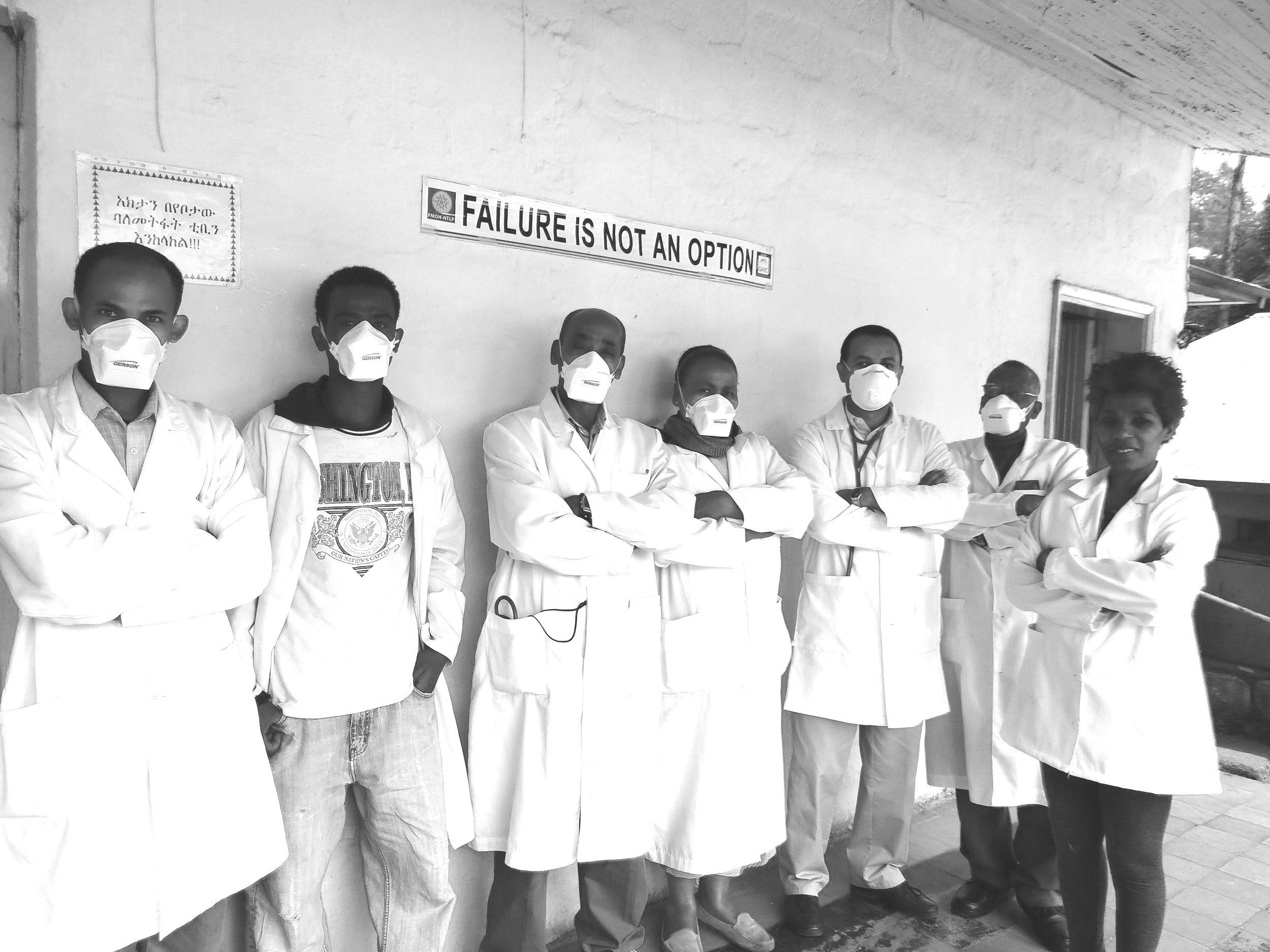
GHC/ St Peters Medical Team on the drug resistant-tuberculosis ward at St Peter’s Hospital.




